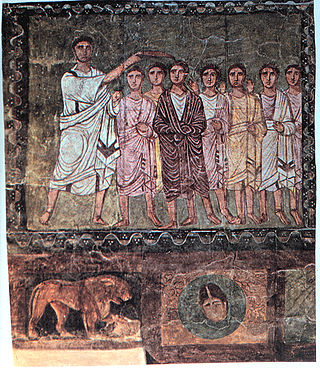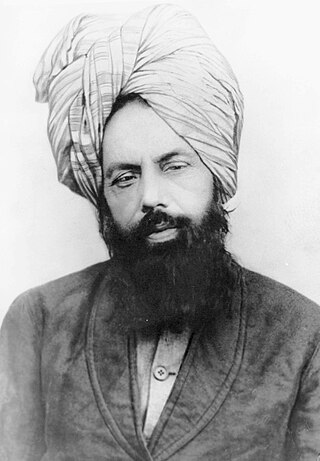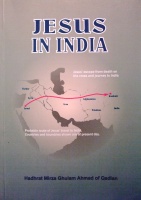Related Research Articles

In Abrahamic religions, a messiah or messias is a saviour or liberator of a group of people. The concepts of mashiach, messianism, and of a Messianic Age originated in Judaism, and in the Hebrew Bible, in which a mashiach is a king or High Priest traditionally anointed with holy anointing oil.
The Second Coming is the Christian belief that Jesus Christ will return to Earth after his ascension to heaven. The idea is based on messianic prophecies and is part of most Christian eschatologies. Other faiths have various interpretations of it.

In Islam, Jesus is believed to be the penultimate prophet and messenger of God and the Messiah sent to guide the Children of Israel with a book called the Injīl.

Comparative religion is the branch of the study of religions with the systematic comparison of the doctrines and practices, themes and impacts of the world's religions. In general the comparative study of religion yields a deeper understanding of the fundamental philosophical concerns of religion such as ethics, metaphysics and the nature and forms of salvation. It also considers and compares the origins and similarities shared between the various religions of the world. Studying such material facilitates a broadened and more sophisticated understanding of human beliefs and practices regarding the sacred, numinous, spiritual and divine.
Christianity and other religions documents Christianity's relationship with other world religions, and the differences and similarities.
The religious perspectives on Jesus vary among world religions. Jesus' teachings and the retelling of his life story have significantly influenced the course of human history, and have directly or indirectly affected the lives of billions of people, including non-Christians. He is considered by many to be one of the most influential persons to have ever lived, finding a significant place in numerous cultural contexts.

Mirza Ghulam Ahmad was an Indian religious leader and the founder of the Ahmadiyya movement in Islam. He claimed to have been divinely appointed as the promised Messiah and Mahdī—which is the metaphorical second-coming of Jesus (mathīl-iʿIsā), in fulfillment of the Islamic prophecies regarding the end times, as well as the Mujaddid of the 14th Islamic century.
Messianism is the belief in the advent of a messiah who acts as the savior of a group of people. Messianism originated as a Zoroastrianism religious belief and followed to Abrahamic religions, but other religions have messianism-related concepts. Religions with a messiah concept include Judaism (Mashiach), Christianity (Christ), Islam, Druze faith, Zoroastrianism (Saoshyant), Buddhism (Maitreya), Taoism, and Bábism.

Ahmadiyya Islam considers Jesus (ʿĪsā) as a mortal man, entirely human, and a prophet of God born to the Virgin Mary (Maryam). Jesus is understood to have survived the crucifixion based on the account of the canonical Gospels, the Qurʾān, hadith literature, and revelations to Mirza Ghulam Ahmad. Having delivered his message to the Israelites in Judea, Jesus is understood to have emigrated eastward to escape persecution from Judea and to have further spread his message to the Lost Tribes of Israel. In Ahmadiyya Islam, Jesus is thought to have died a natural death in India. Jesus lived to old age and later died in Srinagar, Kashmir, and his tomb is presently located at the Roza Bal shrine.

Al-Masih ad-Dajjal, otherwise referred to simply as the Dajjal, is an evil figure in Islamic eschatology who will pretend to be the promised Messiah and later claim to be God, appearing before the Day of Judgment according to the Islamic eschatological narrative. The word Dajjal is not mentioned in the Quran, but he is mentioned and described in the Hadith. Corresponding to the Antichrist in Christianity, the Dajjal is said to emerge out in the East, although the specific location varies among the various sources.

The swoon hypothesis is any of a number of ideas that aim to explain the resurrection of Jesus, proposing that Jesus did not die on the cross, but merely fell unconscious ("swooned"), and was later revived in the tomb in the same physical body. According to the proponents of the swoon hypothesis, the appearances of the risen Jesus to his disciples following his physical resurrection from the dead three days in the tomb were merely perceived to be resurrection appearances by his followers; proponents of the swoon hypothesis believe that Jesus allegedly fell unconscious ("swooned") on the cross, survived the crucifixion, and then regained enough strength to appear before them while he was still alive.

The Roza Bal, Rouza Bal, or Rozabal is a shrine located in the Khanyar quarter in downtown area of Srinagar in Kashmir, India. The word roza means tomb, the word bal mean place. Locals believe a sage is buried here, Yuz Asaf, alongside another Muslim holy man, Mir Sayyid Naseeruddin.
The biblical account of the crucifixion, death, and resurrection of Jesus (ʿĪsā) recorded in the Christian New Testament is traditionally rejected by the major branches of Islam, but like Christians they believe that Jesus ascended to heaven and he will, according to Islamic literary sources, return before the end of time. The various sects of Islam have different views regarding this topic; traditionally, mainstream Muslims believe that Jesus was not crucified but was bodily raised up to heaven by God, while Ahmadi Muslims reject this belief and instead contend that Jesus survived the crucifixion, was taken off the cross alive and continued to preach in India until his natural death.

Christianity is the predominant religion in Uganda. According to the 2014 census, over 84 percent of the population was Christian, while about 14 percent of the population adhered to Islam, making it the largest minority religion. Anglicanism and Catholicism are the main Christian denominations in the country.

Rawżat aṣ-ṣafāʾ fī sīrat al-anbiyāʾ w-al-mulūk w-al-khulafāʾ or Rawdatu 's-safa is a Persian-language history of the origins of Islam, early Islamic civilisation, and Persian history by Mīr-Khvānd. The text was originally completed in seven volumes in 1497 AD; the eighth volume is a geographical index. The work is very scholarly, Mīr-Khvānd used nineteen major Arabic histories and twenty-two major Persian ones as well as others which he occasionally quotes. His work was the basis for many subsequent histories including the works of Hajjī Khalfah.

Jesus in India is a treatise written by Mirza Ghulam Ahmad, the founder of the Ahmadiyya Movement in 1889. The treatise, which was then published as a book, puts forward the view that Jesus survived crucifixion, left Judea and migrated eastward in order to continue his mission to the 'Lost Tribes of Israel', traveling through Persia and Afghanistan and eventually dying a natural and honourable death in Kashmir at an old age. The book also makes references to several lost Jewish tribes. Ghulam Ahmad applied textual analysis of both the Gospels and Islamic sources – the Quran and hadith – and also drew upon medical and historical material, including what he claimed were ancient Buddhist records, to argue his case. Some modern scholars such as Norbert Klatt (1988) have rejected Ghulam Ahmad's use of these latter sources as misreadings of material unrelated to Jesus.

Ahmadiyya, officially the Ahmadiyya Muslim Community or the Ahmadiyya Muslim Jama'at (AMJ) is an Islamic revival or messianic movement originating in British India in the late 19th century. It was founded by Mirza Ghulam Ahmad (1835–1908), who claimed to have been divinely appointed as both the Promised Mahdi and Messiah expected by Muslims to appear towards the end times and bring about, by peaceful means, the final triumph of Islam; as well as to embody, in this capacity, the expected eschatological figure of other major religious traditions. Adherents of the Ahmadiyya—a term adopted expressly in reference to Muhammad's alternative name Aḥmad—are known as Ahmadi Muslims or simply Ahmadis.

The Ahmadiyya branch in Islam has relationships with a number of other religions. Ahmadiyya consider themselves to be Muslim, but are not regarded as Muslim by mainstream Islam. Mainstream Muslim branches refer to the Ahmadiyya branch by the religious slur Qadiani, and to their beliefs as Qadianism a name based on Qadian, the small town in India's Punjab region where the founder of Ahmadiyya, Mirza Ghulam Ahmad was born.

The Ahmadiyya is an Islamic movement in Egypt with origins in the Indian subcontinent. Although the earliest contact between Egyptians and the Ahmadiyya movement was during the lifetime of Mirza Ghulam Ahmad, its founder, the movement in Egypt was formally established in 1922 under the leadership of its second Caliph Opposition to the Ahmadiyya grew particularly in the latter part the 20th century and Ahmadis have seen increased hostility in Egypt more recently. There are up to 50,000 Ahmadi Muslims in Egypt.
References
- ↑ "of "Saving the Savior" was by turns a Black Panther, a Black Muslim, an Ahmadi, and finally a Baháʼí."
- ↑ Steven Propp Josu: Prisoner at Shalem: The Story of a Religious Revolutionary 2005 "Abubakr Ben Ishmael Salahuddin wrote Saving the Savior: Did Christ Survive the Crucifixion? (2001), which expounds the same theme, that Jesus survived the crucifixion and moved to Kashmir, India, married and .."
- ↑ BahaiStudies Abu Bakr leaves the Jamaat